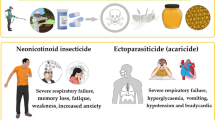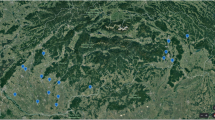Abstract
The migratory locust, Locusta migratoria (Orthoptera: Acrididae), is a well-known edible insect which may serve as new source of human food and animal feed. However, potential toxicity and food safety of L. migratoria had not been investigated extensively until now. Therefore, in this study, we aimed to investigate toxicity of freeze-dried powder of L. migratoria (fdLM) and identify allergic components in ELISA and PCR techniques. In this subchronic study, fdLM was administered once daily by oral gavage at the doses of 750, 1500, and 3000 mg/kg/day. No toxicological changes were observed in both sexes of rats for 13 weeks in accordance with the OECD guidelines and GLP conditions. In addition, fdLM did not induced increases of serum immunoglobulin E and 21 homologous proteins were not detected under our present conditions. In conclusion, the NOAEL (no-observed-adverse-effect level) was 3000 mg/kg/day and no target organ was identified in both sexes. In conclusion, we found that fdLM is safe with no adverse effects and offers the potential of its use as an edible ingredient or other biological uses.




Similar content being viewed by others
References
Van Huis, A, Van Itterbeeck J, Klunder H, Mertens E, Halloran A, Muir G, Vantomme P (2013) Edible insects: future prospects for food and feed security. FAO For Pap 171. https://library.wur.nl/WebQuery/wurpubs/fulltext/258042
Siemianowska E, Kosewska A, Aljewicz M, Skibniewska K, Polak-Juszczak L, Jarocki A, Jędras M (2013) Larvae of mealworm (Tenebrio molitor L.) as European novel food. Agri Sci 4:287–291. https://doi.org/10.4236/as.2013.46041
Clarkson C, Mirosa M, Birch J (2018) Potential of extracted Locusta migratoria protein fractions as value-added ingredients. Insects 9:20. https://doi.org/10.3390/insects9010020
Mohamed EHA (2015a) Determination of nutritive value of the edible migratory locust Locusta migratoria, Linnaeus, 1758(Orthoptera: Acrididae). Int J Adv Pharm Biol Chem 4:144–148. https://www.ijapbc.com/files/20-34196.pdf
Mohamed EHA (2015b) Fatty acids contents of the edible migratory locust Locusta migratoria, Linnaeus, 1758 (Orthoptera: Acrididae). Int J Adv Pharm Biol Chem 4:746–750. http://www.ijapbc.com/files/21-10-15/03-4129.pdf
Kim TS, Lee JH, Choi BD, Ryu HS (1987) Nutritional value of dried paddy grasshopper, Oxya chinensis formosana. J food Sci Nut 16:98–104. https://koreascience.kr/article/JAKO198703042275128.page
Kim HJ, Kang SJ, Kim SG, Kim JE, Koo HY (2014) Antioxidant activity and antimicrobial activity of the grasshopper, Oxya chinensis sinuosa. J Agric Sci Technol 49:19–26. https://doi.org/10.7852/jses.2015.53.2.130
Lee HJ, Seo M, Lee JH, Kim IW, Kim SY, Hwang JS, Kim MA (2018) Anti-neuroinflammatoy effects of a Locusta migratoria ethanol extract in LPS-stimulated BV-2 microglia. J Life Sci 28:1332–1338. https://doi.org/10.5352/JLS.2018.28.11.1332
Baek M, Seo M, Lee JH, Kim IW, Kim MA, Hwang JS (2018) Osteoblastogenic activity of Locusta migratoria ethanol extracts on pre-osteoblastic MG-63 cells. J Life Sci 28:1448–1454. https://doi.org/10.5352/JLS.2018.28.12.1448
Baek M, Seo M, Lee JH, Lee HJ, Kim IW, Kim SY, Kim MA, Kim S, Hwang JS (2019) Inhibitory effects of Locusta migratoria ethanol extracts on RANKL-induced osteoblast differentiation. J Life Sci 29:1104–1110. https://doi.org/10.5352/JLS.2019.29.10.1104
Han S, Yun E, Kim J, Hwang JS, Jeong EJ, Moon K (2014) Evaluation of genotoxicity and 28-day oral dose toxicity on freeze-dried powder of Tenebrio molitor larvae (Yellow Mealworm). Toxicol Res 30:121–130. https://doi.org/10.5487/TR.2014.30.2.121
Noh J, Yun E, Park H, Jung K, Hwang JS, Jeong EJ, Moon K (2015) Subchronic oral dose toxicity of freeze–dried powder of Allomyrina dichotoma larvae. Toxicol Res 31:3169–3175. https://doi.org/10.5487/TR.2015.31.1.069
Lee S, Ahn K, Ryu HY, Kim HJ, Lee JK, Cho M, Ahn MY, Song KS (2016) Safety evaluation of cricket (Gryllus bimaculatus) extract in Sprague-Dawley rats. Int J Indust Entomol 32:12–25. https://doi.org/10.7852/ijie.2016.32.1.12
Pener MP (2014) Allergy to locusts and acridid grasshoppers: a review. J Orthoptera Res 23:59–67. https://doi.org/10.1665/034.023.0105
Panzani RC, Ariano R (2001) Arthropods and invertebrates allergy (with the exclusion of mites): the concept of pan allergy. Allergy 56:1–22. https://doi.org/10.1111/j.1398-9995.2001.tb04419.x
Frankland AW (1953) Locust sensitivity. Ann Allergy 11:445–453 (PMID: 13080871)
Holgate ST, Polosa R (2008) Treatment strategies for allergy and asthma. Nat Rev Immunol 8:218–230. https://doi.org/10.1038/nri2262
Awoniyi TAM, Adetuyi FC, Akinyosoye FA (2004) Microbiological investigation of maggot meal stored for use as a livestock feed component. J Food Agric Environ 2:104–106. https://doi.org/10.1234/4.2004.265
Téguia A, Mpoam M, Okourou Mba JA (2002) The production performance of broiler birds as affected by the replacement of fish meal by maggot meal in the starter and finisher diets. Tropicult 20:187–192. http://www.tropicultura.org/text/v20n4/187.pdf
OECD (1997) OECD principles of Good Laboratory Practice. ENV/MC/CHEM (98)17
MFDS in Republic of Korea (2017) Good laboratory practice regulation for non-clinical laboratory studies. notification no. 2017–32, May 01, 2017
Kim SY, Kim HG, Ko HJ, Kim MA, Kim IW, Seo MC, Lee JH, Lee HJ, Baek M, Hwang JS, Yoon HJ (2019) Comparative analysis of nutrients and hazardous substances in Zophobas atratus larvae. J Life Sci 29:1378–1385. https://doi.org/10.5352/JLS.2019.29.12.1378
National Research Council (US) Committee for the Update of the Guide for the Care and Use of Laboratory Animals (2011) Guide for the Care and Use of Laboratory Animals, 8th edn. National Academies Press (US)
Kang KY, Kim MS, Lee MS, Oh JJ, An S, Park D, Heo IK, Lee HK, Song SW, Kim SD (2020) Genotoxicity and acute toxicity evaluation of the three amino acid additives with Corynebacterium glutamicum biomass. Toxicol Rep 7:241–253. https://doi.org/10.1016/j.toxrep.2020.01.013
Ha DH, Kim SD, Lee J, Kwon HH, Park GH, Yang SH, Jung JY, Lee JH, Park SR, Youn J, Lee SH, Lim J, Lee HK, Cho BS, Yi YW (2020) Toxicological evaluation of exosomes derived from human adipose tissue-derived mesenchymal stem/stromal cells. Regul Toxicol Pharmacol 115:104686. https://doi.org/10.1016/j.yrtph.2020.104686
Kim SY, Kwak KW, Park ES, Yoon HJ, Kim YS, Park K, Kim E, Kim SD (2020) Evaluation of subchronic oral dose toxicity of freeze-dried skimmed powder of Zophobas atratus larvae (frpfdZAL) in rats. Foods 9:995. https://doi.org/10.3390/foods9080995
OECD (1998) OECD guidelines for the testing of chemicals, Test No. 408: repeated dose 90-day oral toxicity study in rodents
Kwak KW, Kim SY, An KS, Kim YS, Park K, Kim E, Hwang JS, Kim MA, Ryu HY, Yoon HJ (2020) Subacute oral toxicity evaluation of freeze-dried powder of Locusta migratoria. Food Sci Anim Resour 40:795–812. https://doi.org/10.5851/kosfa.2020.e55
Díaz-Rúa R, Keijer J, Palou A, van Schothorst EM, Oliver P (2017) Long-term intake of a high-protein diet increases liver triacylglycerol deposition pathways and hepatic signs of injury in rats. J Nutr Biochem 46:39–48. https://doi.org/10.1016/j.jnutbio.2017.04.008
Lee JM, Lee MA, Do HN, Song YI, Bae R, Lee HY, Park SH, Kang JS, Kang JK (2012) Historical control data from 13-week repeated toxicity studies in Crj:CD (SD) rats. Lab Anim Res 28:115–121. https://doi.org/10.5625/lar.2012.28.2.115
Giknis MLA, Clifford CB (2006) Clinical laboratory parameters for Crl:CD(SD) rats. Charles River Laboratories
Metcalfe DD, Sampson H, Simon RA (2009) Food allergy: adverse reaction to foods and food additive. John Wiley and Sons Inc, New York
Pali-Scholl I, Verhoeckx K, Monaci L (2019) Allergenic and novel food proteins: state of the art and challenges in the allergenicity assessment. Trends Food Sci Technol 84:45–48. https://doi.org/10.1016/j.tifs.2018.03.007
de Gier S, Verhoeckx K (2018) Insect (food) allergy and allergens. Mol Immunol 100:82–106. https://doi.org/10.1016/j.molimm.2018.03.015
Pali-Scholl I, Meinlschmidt P, Larenas-Linnemann E, Purschke B, Hofstetter G, Rodríguez-Monroy FA, Einhorn K, Mothes-Luksch N, Jensen-Jarolim J, Joager H (2019) Edible insects: Cross-recognition of IgE from crustacean- and house dust mite allergic patients, and reduction of allergenicity by food processing. World Allergy Org J 12:100006. https://doi.org/10.1016/j.waojou.2018.10.001
Ochiai M, Inada M, Horiguch S (2020) Nutritional and safety evaluation of locust (Caelifera) powder as a novel food material. J Food Sci 85:279–288. https://doi.org/10.1111/1750-3841.15024
EFSA Panel on Nutrition, Novel Foods and Food allergens (NDA) et al (2021) Safety of frozen and dried formulations from migratory locust (Locusta migratoria) as a Novel pursuant to regulation (EU) 2015/2283. EFSA J 19:6667. https://doi.org/10.2903/j.efsa.2021.6667
Jofuku KD, Okamuro JK, Goldberg RB (1987) Interaction of an embryo DNA binding protein with a soybean lectin gene upstream region. Nature 328:734–737. https://doi.org/10.1038/328734a0
Vodkin LO, Rhodes PR, Goldberg RB (1983) cA lectin gene insertion has the structural features of a transposable element. Cell 34:1023–1031. https://doi.org/10.1016/0092-8674(83)90560-3
He G, Meng R, Newman M, Gao G, Pittman RN, Prakash CS (2003) Microsatellites as DNA markers in cultivated peanut (Arachis hypogaea L.). BMC Plant Biol 3:3. http://www.biomedcentral.com/1471-2229/3/3
Wu SB, Franks TK, Hunt P, Wirthensohn MG, Gibson JP, Sedgley M (2010) Discrimination of SNP genotypes associated with complex haplotypes by high resolution melting analysis in almond: implications for improved marker efficiencies. Mol Breed 25:351–357. https://doi.org/10.1007/s11032-009-9324-5
Cheng F, Wu J, Zhang J, Pan A, Quan S, Zhang D, Kim HY, Li X, Zhou S, Yang L (2016) Development and inter-laboratory transfer of a decaplex polymerase chain reaction assay combined with capillary electrophoresis for the simultaneous detection of ten food allergens. Food Chem 199:799–808. https://doi.org/10.1016/j.foodchem.2015.12.058
Smith JJ, Raikhel NV (1989) Nucleotide sequences of cDNA clones encoding wheat germ agglutinin isolectins A and D. Plant Mol Biol 13:601–603. https://doi.org/10.1007/BF00027321
Sano M, Nakagawa M, Oishi A, Yasui Y, Katsube-Tanaka T (2014) Diversification of 13S globulins, allergenic seed storage proteins, of common buckwheat. Food Chem 55:192–198. https://doi.org/10.1016/j.foodchem.2014.01.047
Shirasawa K, Asamizu E, Fukuoka H, Ohyama A, Sato S, Nakamura Y, Tabata S, Sasamoto S, Wada T, Kishida Y, Tsuruoka H, Fujishiro T, Yamada M, Isobe S (2010) An interspecific linkage map of SSR and intronic polymorphism markers in tomato. Theor Appl Genet 121:731–739. https://doi.org/10.1007/s00122-010-1344-3
Cipriani G, Lot G, Huang WG, Marrazo MT, Peterlunger E, Testolin R (1999) AC/GT and AG/CT microsatellite repeats in peach [Prunus persica (L.) Batsch]: isolation, characterization and cross-species amplification in Prunus. Theor Appl Genet 99:65–72. https://doi.org/10.1007/s001220051209
Dooley JJ, Paine KE, Garrett SD, Brown HM (2004) Detection of meat species using TaqMan real-time PCR assays. Meat Sci 68:431–438. https://doi.org/10.1016/j.meatsci.2004.04.010
Niu T, Yu L, He X, Zhao S, Xu C (2019) The complete mitochondrial genome of Min pig (Hebao) and a phylogenetic analysis. Mitochondrial DNA B Resour 4:3657–3658. https://doi.org/10.1080/23802359.2019.1678424
Heumann-Kiesler C, Sommerfeld V, Iffland H, Bennewitz J, Rodehutscord M, Hasselmann M (2021) Insights into the mitochondrial and nuclear genome diversity of two high yielding strains of laying hens. Animals 11:825. https://doi.org/10.3390/ani11030825
**a X, Huang G, Wang Z, Sun J, Wu Z, Chen N, Lei C, Hanif Q (2019) Mitogenome diversity and maternal origins of Guangxi cattle breeds. Animals 10:19. https://doi.org/10.3390/ani10010019
Froman DP, Kirby JD (2005) Sperm mobility: phenotype in roosters (Gallus domesticus) determined by mitochondrial function. Biol Reprod 72:562–567. https://doi.org/10.1095/biolreprod.104.035113
Park YC, Kim MR, Shin JH, Kim KH, Lee JH, Cho TY, Lee HJ, Lee SJ, Han SB (2013) Development of PCR method for rapid detection of allergic materials in foods. J Food Hyg Saf 28:124–129. https://doi.org/10.13103/JFHS.2013.28.2.124
Suh SM, Kim MJ, Kim HI, Kim HJ, Kim HY (2020) A multiplex PCR assay combined with capillary electrophoresis for the simultaneous detection of tropomyosin allergens from oyster, mussel, abalone, and clam mollusk species. Food Chem 317:126451. https://doi.org/10.1016/j.foodchem.2020.126451
Wilson K, Cahill V, Ballment E, Benzie J (2000) The complete sequence of the mitochondrial genome of the crustacean Penaeus monodon: are malacostracan crustaceans more closely related to insects than to branchiopods? Mol Biol Evol 17:863–874. https://doi.org/10.1093/oxfordjournals.molbev.a026366
Funding
This work was supported by a grant from the Agenda Program, Rural Development Administration in Republic of Korea [Grant No. PJ01352502]. We thank Roger Scott Fields (English editor) for his editing of our submission.
Author information
Authors and Affiliations
Corresponding authors
Ethics declarations
Conflict of interest
The authors declare that there is no conflict of interest.
Rights and permissions
Springer Nature or its licensor (e.g. a society or other partner) holds exclusive rights to this article under a publishing agreement with the author(s) or other rightsholder(s); author self-archiving of the accepted manuscript version of this article is solely governed by the terms of such publishing agreement and applicable law.
About this article
Cite this article
Kim, S.Y., Kwak, KW., Park, J.Y. et al. Evaluation of subchronic oral dose toxicity and allergen of freeze-dried powder of Locusta migratoria (Orthoptera: Acrididae) as a novel food source. Toxicol Res. 39, 317–331 (2023). https://doi.org/10.1007/s43188-023-00171-7
Received:
Revised:
Accepted:
Published:
Issue Date:
DOI: https://doi.org/10.1007/s43188-023-00171-7




